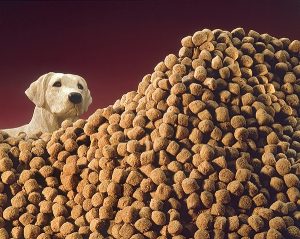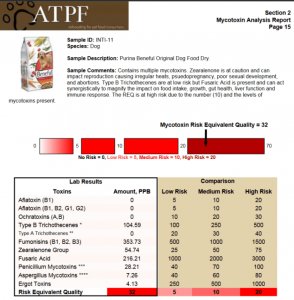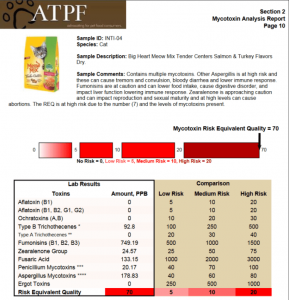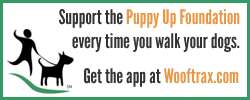
From Truth About Pet Food
Grains in pet foods come with risks; a different set of risks than the current grain-free pet food potential risk to heart disease.
The FDA alerted pet owners to a current investigation into the “Potential Connection Between Diet and Canine Heart Disease” in July 2018. Though no scientific reason for the link has been released, the FDA states “The U.S. Food and Drug Administration is alerting pet owners and veterinary professionals about reports of canine dilated cardiomyopathy (DCM) in dogs eating certain pet foods containing peas, lentils, other legume seeds, or potatoes as main ingredients. High levels of legumes or potatoes appear to be more common in diets labeled as “grain-free,” but it is not yet known how these ingredients are linked to cases of DCM.”
Because of this current risk of grain-free pet food, many pet owners are being urged to return to grain-included diets. But…grain-included pet foods come with another set of risks.
The risk is mycotoxins.
High levels of mycotoxins are deadly, and even low levels consumed over time are linked to liver disease, kidney disease and cancer.
“Mycotoxins are toxic secondary metabolites produced by certain filamentous fungi (molds). These low molecular weight compounds are naturally occurring and practically unavoidable. They can enter our food chain either directly from plant-based food components contaminated with mycotoxins or by indirect contamination from the growth of toxigenic fungi on food. Mycotoxins can accumulate in maturing corn, cereals, soybeans, sorghum, peanuts, and other food and feed crops in the field and in grain during transportation.”
Source: https://www.ncbi.nlm.nih.gov/pmc/articles/PMC5486318/
Abstract from “Mycotoxins in pet food: a review on worldwide prevalence and preventative strategies“:
Mycotoxins contaminate cereal grains worldwide, and their presence in pet food has been a potential health threat to companion animals. Aflatoxins, ochratoxin A, and Fusarium mycotoxins have been found in both raw ingredients and final products of pet food around the globe. Grain processing, sampling error, analytical methods, conjugated mycotoxins, storage conditions, and synergistic interactions are common challenges faced by the pet food industry.
From the full paper “Mycotoxins and the pet food industry: Toxicological evidence and risk assessment“:
Mycotoxin contamination in pet food poses a serious health threat to pets, causing an emotional and economical concern to the pet owners. Aflatoxins, ochratoxins, trichothecenes, zearalenone, fumonisins and fusaric acid have been found in the ingredients and final products of pet food, resulting in both acute toxicity and chronic health problems in pets. Toxicological interaction among mycotoxins as a natural mixture further complicates the issue.
Aflatoxins have been the most common cause of acute mycotoxin outbreaks in commercial dog food. Corn is the usual source of aflatoxins in these cases. These available reports of acute mycotoxicosis, however, cannot provide the whole picture of the mycotoxin problem associated with pet foods since only a small number of food poisoning cases are published. Veterinarians, furthermore, often overlooked mycotoxins as the cause of chronic diseases such as liver and kidney fibrosis, infections resulting from immunosuppression and cancer. These findings suggest that mycotoxin contamination in pet food poses a serious health threat to pet species.
From the same paper as above, effects of different types of mycotoxins in pets are explained in more detail.
Aflatoxins. The primary clinical effects in aflatoxicosis are related to hepatic damage in all species studied. In acute aflatoxicosis, dogs exposed to >0.5–1 mg aflatoxin/kg body weight (BW) typically die within days, showing enlarged livers, disseminated intravascular coagulation and internal hemorrhaging. Sub-acute aflatoxicosis (0.5–1 mg aflatoxin/kg pet food) is characterized by anorexia, lethargy, jaundice, intravascular coagulation and death in 2–3 weeks. Similar hepatotoxic effects can also be produced by chronic aflatoxin exposure with 0.05–0.3 mg aflatoxin/kg pet food over 6–8 weeks.
In addition to their hepatotoxic properties, aflatoxins are also carcinogenic. The binding of DNA causes genotoxicity and mutation in cells. The chronic carcinogenic dose of aflatoxins is much lower than the acute dose. Since aflatoxins are both acute and chronic hepatotoxins and carcinogens, the actual number of dogs affected by aflatoxins would be far more than the total number reported in acute poisoning cases.
Ochratoxins. Ochratoxins are a group of potent renal mycotoxins that widely contaminate the agricultural commodities, such as corn, wheat, oats and dried beans, in temperate regions.
Upon absorption, ochratoxins enter the circulatory system, bind tightly to serum proteins and accumulate in the kidneys, where they disrupt protein synthesis and other pathways in proximal tubular cells. OTA is also known to bind with DNA molecules and induce renal tumors in animal models, although its carcinogenic mechanism remains controversial.
Clinical symptoms of the OTA poisoning included anorexia, weight loss, vomiting, tenesmus, bloody diarrhea, increased body temperature, tonsillitis, dehydration, and prostration.
Trichothecenes. Trichothecenes are a family of Fusarium mycotoxins commonly found in corn, wheat, barley, as well as oats worldwide.
Trichothecenes are potent irritants and inhibitors of protein and DNA synthesis which interferes with cellular metabolic activities, ultimately leading to cell death.
Zearalenone. Zearalenone is an estrogenic Fusarium mycotoxin found in various cereal crops, most frequently in corn.
Both male and female dogs are affected by zearalenone toxicity. Some recent studies suggested that low levels of zearalenone exposure can also produce significant toxic effects.
Fumonisins. Fumonisins are found in corn throughout the world with more than 15 homologues isolated. Once they enter the blood circulation, fumonisins damage numerous organs in all species studied.
Mycotoxins also have a synergistic effect when 2 or more are found in a pet food. “The toxicity of a particular mycotoxin, therefore, depends on not only its own concentration but also the presence of other mycotoxins.”
As example of dangerous synergy when multiple mycotoxins are present in a pet food is results from our consumer funded pet food testing performed in 2015.

The above sampled Purina Beneful Dog Food contained 10 different types of mycotoxins. Each mycotoxin was below FDA’s maximum allowed level individually (FDA has not established maximum levels for multiple mycotoxins present in pet foods), however based on industry based science our scientists classified this pet food has High Risk “due to number (10) and the levels of mycotoxins present.”

And again, this time with Big Heart Meow Mix cat food, our results showed all individual mycotoxins were below FDA allowed maximum. However, when the collective effect of mycotoxins were considered per scientific evidence, this pet food rated “at high risk due to number (7) and the levels of mycotoxins present.”
Another issue to consider with grain-included feed grade pet foods is the same consideration for all feed grade ingredients – the ‘feed’ system of regulation. Feed and feed ingredients are openly allowed by FDA to utilize what the food industry considers as waste. As example, the FDA allows “the diversion of moisture-damaged grain as well as other food materials for animal feed use.”
Below is an image of feed grade corn, stored in the middle of a field in Iowa (provided by a Iowa pet owner). Notice the grain is not under cover or protected from weather, insects or animals. This ‘storage’ of grain is openly allowed in feed.

Because mycotoxins are such a significant threat to all animals, each year various groups “survey” the grain productions for mycotoxin contaminations. Below is one of those survey’s for grain production in the U.S. last year.
Adisseo’s 2018 Mycotoxin Survey found that almost half of corn and silage samples taken in the U.S. were contaminated with zearalenone (ZEN) and more than 70 percent were contaminated with deoxynivalenol (DON), making the 2018 U.S. corn harvest of medium quality in terms of mycotoxin contamination.
The results showed that 49 percent of silage samples and 20 percent of corn samples were contaminated with ZEN.
Eighty percent of silage samples and 73 percent of corn samples were contaminated with DON.
Only 3 percent of samples had low levels of AfB1.
Several samples had two to four mycotoxins detected, which could lead to synergistic interactions. Forty-nine percent of samples were contaminated with two mycotoxins; 23 percent with three mycotoxins.
Another mycotoxin survey from Biomin.net states:
Our April update from the annual Biomin® PROcheck mycotoxin survey in corn harvested in 2018 includes 572 samples from 31 states.
Corn
98% of ground corn samples are positive for at least one mycotoxin, vs 89% in 2017
72% of samples have more than one mycotoxin, vs 47% in 2017
Aflatoxin prevalence in dry corn increased to 10% vs 4% in 2017, with average contamination levels increasing over four fold.
Deoxynivalenol (vomitoxin) prevalence rose to 76% vs 70% in 2017, with average contamination level increasing by 44%
Fumonisin prevalence jumped to 79% vs 52% in 2017, with average contamination levels increasing by 45%
Zearalenone prevalence increased to 45% vs 25% in 2017, with average contamination levels remaining steady.
Grains in pet food come with mycotoxin risks. Grain-free pet foods are currently linked to cases of heart disease in dogs. What are pet owners to do?
There is no easy answer to this question. The FDA states: “It’s important to note that the reports (cases of diet-related DCM reported to FDA) include dogs that have eaten grain-free and grain containing foods, and also include vegetarian or vegan formulations. They also include all forms of diets: kibble, canned, raw and home-cooked. This is why we do not think these cases can be explained simply by whether or not they contain grains, or by brand or manufacturer.”
Personal opinion: No one has publicly provided the cause confirming the link between grain-free pet foods and canine heart disease. The unknown is frightening. Dogs have become sick and many have died linked to grain-free pet food. However, the other side of grain-free pet food is grain-included pet food that – as evidenced by decades of science – come with mycotoxin risks.
Would I give my own pets a grain-free commercial pet food? Yes, I would – and I do. My pets consume a human grade (made under constant USDA inspection) grain-free raw pet food – this is half of their diet (2 dogs, 5 cats).
Would I give my own pets grain? Yes, I would – and I do in a rotation of home prepared cooked foods which makes up the other half of my pets diet. Grain is not included with every batch of pet food I make, but it is included in the recipes I make. Significant to me, the grains I provide my pets in their rotation of recipes are human edible (human grade) grains purchased from my grocery store (though almost all are organic).
Would I give my own pets a feed grade grain-free or grain-included pet food? No, I would not.
And lastly, though I am certain it will be perceived by some as an attack, the intent of this post is to provide pet owners with scientific information about the risk of grains. It is one of several over many years that TruthaboutPetFood.com has published on the risk of grains. It is our belief that pet owners are fully capable of making their own pet food decisions when provided with all sides of an issue. Mycotoxin risk in pet food is definitely another side that needs to be well known.
Wishing you and your pet(s) the best,
Susan Thixton
Pet Food Safety Advocate
Author Buyer Beware, Co-Author Dinner PAWsible
TruthaboutPetFood.com
Association for Truth in Pet Food








